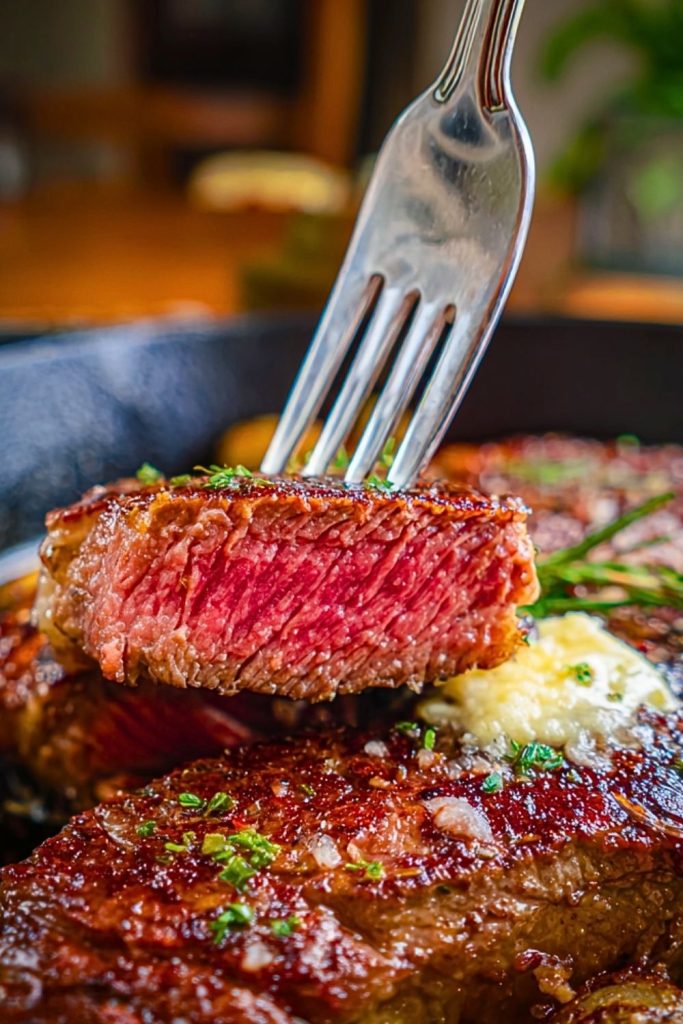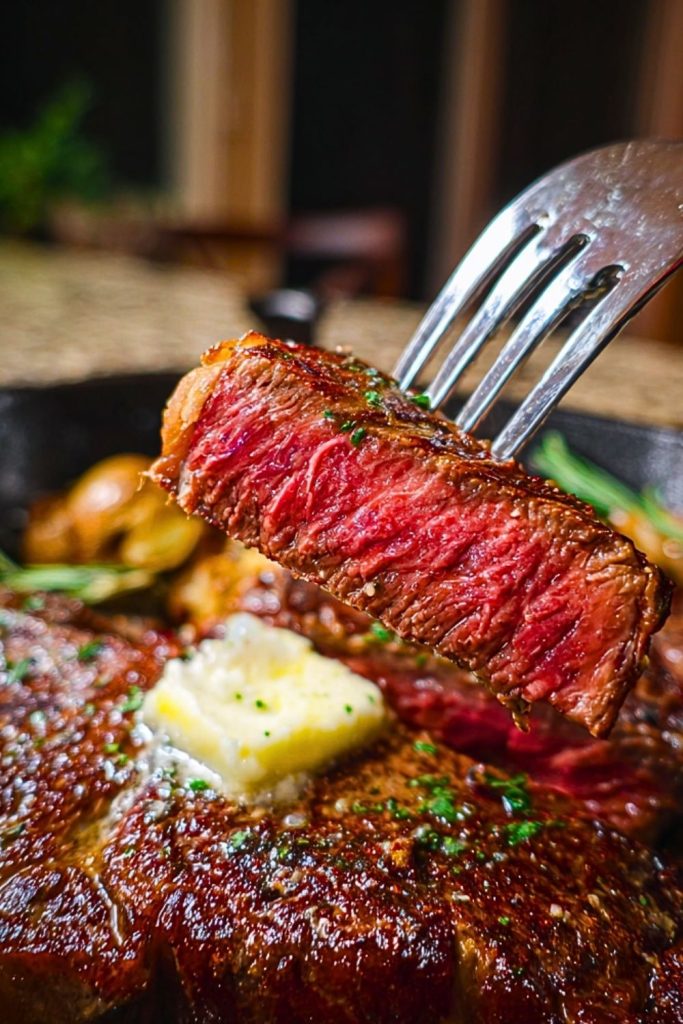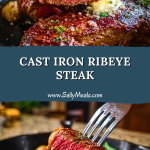There’s something incredibly satisfying about cooking a thick, beautifully marbled ribeye steak in a cast iron skillet. I love the way the hot iron sears the exterior into a caramelized crust while keeping the inside perfectly juicy and tender. It’s that steakhouse-quality flavor right in your own kitchen — no grill needed, no fuss involved. Whenever I crave a meal that feels indulgent yet simple to make, this is the dish I turn to.

What makes cast iron cooking so special is the even heat distribution and the ability to go from stovetop to oven effortlessly. With just a few ingredients — salt, pepper, butter, garlic, and rosemary — this ribeye steak becomes a full sensory experience. I’ve made this for weeknight dinners, romantic date nights, and even special occasions, and it never disappoints. It’s one of those recipes you memorize and make your own with time.
Why You’ll Love This Cast Iron Ribeye Steak
This steak is all about flavor and ease. With a crisp, seasoned crust and a tender, juicy center, it delivers that perfect bite every time. The butter and garlic baste adds richness, while rosemary brings a fragrant finish. Plus, it’s a one-pan wonder, making cleanup minimal and the results restaurant-level. Whether you’re cooking for one or impressing guests, this ribeye is guaranteed to steal the show.
What Cut of Ribeye Should I Use?
Not all ribeyes are created equal, and for this recipe, I always look for a well-marbled, bone-in ribeye that’s at least 1 to 1½ inches thick. The bone adds flavor and helps the meat cook more evenly, while the fat marbling keeps the steak juicy. If you’re at the butcher, ask for a USDA Prime or Choice cut. Thinner steaks tend to overcook too quickly, especially in a hot cast iron skillet, so don’t shy away from a thick cut.
Options for Substitutions
If you don’t have ribeye, there are a few great alternatives. A New York strip steak or filet mignon can be seared similarly, though they may need slightly different cooking times. For butter alternatives, try ghee for a nutty flavor or olive oil if you’re avoiding dairy. Don’t have fresh rosemary? Thyme or sage works beautifully too. You can even use shallots in place of garlic for a milder flavor. The method stays the same — it’s all about high heat, quick sear, and finishing with love (and butter).
Ingredients for This Cast Iron Ribeye Steak
Ribeye Steak (bone-in, 1 to 1½ inches thick)
This is the star of the dish. The marbling in a ribeye gives it unmatched juiciness and flavor, especially when seared in a hot skillet.
Kosher Salt
Salt brings out the natural flavors of the beef. A generous seasoning before cooking is essential to develop a crust.
Freshly Cracked Black Pepper
Pepper adds a gentle heat and bold aroma, balancing the richness of the steak.
Unsalted Butter
Used for basting, butter adds richness and creates that signature golden-brown finish on the steak.
Garlic Cloves (smashed)
Garlic infuses the butter as it browns, adding deep, savory undertones.
Fresh Rosemary Sprigs
Rosemary adds a burst of herbaceous fragrance and elevates the flavor of the steak as it cooks.
Olive Oil
A quick brush of oil helps the steak sear evenly and prevents sticking.

Step 1: Let the Steak Come to Room Temperature
Remove the ribeye from the refrigerator about 30–45 minutes before cooking. This helps it cook more evenly and ensures a better sear.
Step 2: Season Generously
Pat the steak dry with paper towels, then season both sides with kosher salt and freshly cracked black pepper. Press the seasoning into the meat so it adheres well.
Step 3: Preheat the Cast Iron Skillet
Place your cast iron skillet over medium-high heat and let it get smoking hot — about 5 minutes. A hot pan is key to a great crust.
Step 4: Sear the Steak
Add a small amount of olive oil to the skillet. Gently place the steak in the pan and sear without moving it for about 3–4 minutes until a crust forms. Flip and sear the other side for another 3–4 minutes.
Step 5: Baste With Butter, Garlic, and Rosemary
Add butter, smashed garlic cloves, and rosemary sprigs to the pan. Tilt the skillet slightly and use a spoon to baste the steak continuously with the melted butter and aromatics for 1–2 minutes.
Step 6: Check Internal Temperature
For medium-rare, aim for 130–135°F (54–57°C) internal temperature. Insert a meat thermometer into the thickest part of the steak to check.
Step 7: Rest Before Slicing
Transfer the steak to a cutting board and let it rest for 5–10 minutes. This allows juices to redistribute and keeps the meat tender and flavorful.
How Long to Cook the Cast Iron Ribeye Steak
Cooking time depends on the thickness of the steak and your preferred doneness. For a 1½-inch thick ribeye:
- Rare (120–125°F): 2–3 minutes per side
- Medium-Rare (130–135°F): 3–4 minutes per side
- Medium (140–145°F): 4–5 minutes per side
- Medium-Well (150–155°F): 5–6 minutes per side
Always use a meat thermometer to get an accurate reading, especially since cast iron retains heat and can cook quickly.
Tips for Perfect Cast Iron Ribeye Steak
- Preheat the pan properly: A hot skillet is essential for a golden-brown crust. Let it heat up for several minutes before adding the steak.
- Don’t overcrowd the pan: Cook one steak at a time to ensure even searing.
- Use a high smoke point oil: Olive oil or avocado oil helps prevent burning while searing.
- Baste with aromatics: Butter, garlic, and rosemary add complexity and richness to the flavor.
- Let it rest: Always give your steak time to rest before slicing — this keeps it juicy and tender.
- Slice against the grain: This shortens the muscle fibers and makes each bite more tender.
Watch Out for These Mistakes While Cooking
- Not drying the steak: Moisture on the surface will prevent a good sear. Pat it dry thoroughly with paper towels before seasoning.
- Underseasoning: Be generous with salt and pepper. It enhances the natural flavors of the meat and forms that delicious crust.
- Flipping too soon: Let the steak sit undisturbed to form a proper crust. Avoid moving it around the skillet.
- Skipping the thermometer: Guessing the doneness can lead to overcooked or undercooked steak. A thermometer ensures precision.
- Forgetting to rest the meat: Cutting into the steak too soon releases all the juices. Let it sit so the juices redistribute.
- Using cold steak: Cooking a chilled steak results in uneven cooking. Let it come to room temperature first.
What to Serve With Cast Iron Ribeye Steak?
Garlic Mashed Potatoes
Creamy, buttery, and a perfect comfort side that complements the rich steak.
Grilled Asparagus
Lightly charred with a touch of lemon zest — it adds brightness and crunch.
Caesar Salad
A crisp, refreshing salad with a creamy dressing balances the meal beautifully.
Roasted Brussels Sprouts
Crispy, caramelized, and slightly bitter, they pair well with the fattiness of the ribeye.
Crusty Artisan Bread
Great for soaking up the buttery pan juices left from the steak.
Mac and Cheese
Creamy and cheesy, it turns your ribeye meal into indulgent comfort food.
Red Wine Reduction Sauce
If you’re feeling fancy, a quick reduction sauce adds elegance and extra depth.
Sweet Potato Fries
A touch of sweetness and crispiness that contrasts beautifully with the steak’s richness.
Storage Instructions
If you have leftovers, store the cooked ribeye steak in an airtight container in the refrigerator for up to 3 days. To reheat, let the steak come to room temperature, then warm it gently in a skillet over low heat with a bit of butter to keep it moist. Avoid using the microwave — it tends to dry out the meat and ruin the texture.
You can also freeze leftover steak. Wrap it tightly in plastic wrap, followed by foil, and place it in a freezer-safe bag. It will keep well for up to 2 months. Thaw overnight in the fridge before reheating.
Estimated Nutrition (per serving – based on a 12 oz ribeye)
- Calories: 720
- Protein: 50g
- Fat: 55g
- Saturated Fat: 24g
- Cholesterol: 165mg
- Carbohydrates: 1g
- Fiber: 0g
- Sugar: 0g
- Sodium: 420mg
Note: These values are estimates and can vary depending on the size of the steak and the amount of butter or seasoning used.
Frequently Asked Questions
Can I use a boneless ribeye instead of bone-in?
Yes, boneless ribeye works just as well. The cooking time may be slightly shorter, so monitor the internal temperature closely.
Do I need to use a cast iron skillet?
While cast iron is ideal for heat retention and searing, a heavy-bottomed stainless steel pan can also do the job.
Can I cook the steak entirely on the stovetop?
Absolutely. If your ribeye isn’t too thick, stovetop searing and basting are enough. For thicker cuts, you can finish it in the oven.
What oil is best for searing the steak?
Use oils with a high smoke point like avocado oil, canola oil, or grapeseed oil. Olive oil is fine but watch the heat.
Is resting the steak really necessary?
Yes, resting allows the juices to redistribute throughout the meat, making it more flavorful and tender.
Can I marinate the ribeye beforehand?
Ribeye doesn’t need a marinade due to its natural fat and flavor, but if you want to, keep it simple with garlic, herbs, and oil.
What’s the best way to reheat leftovers?
Reheat in a skillet over low heat with a bit of butter. Avoid the microwave to preserve texture and flavor.
Should I trim the fat off the ribeye?
Leave it on for cooking — it adds flavor and keeps the steak juicy. You can trim it before serving if desired.
Conclusion
Cooking a Cast Iron Ribeye Steak is one of those simple pleasures that feels luxurious without the need for complex techniques or fancy ingredients. With a sizzling hot skillet, a well-marbled cut, and a handful of aromatics, you can create a steakhouse-level experience right at home. It’s a recipe that rewards attention to detail and brings rich, bold flavor to your plate every time.

Cast Iron Ribeye Steak
- Prep Time: 10 minutes
- Cook Time: 10 minutes
- Total Time: 20 minutes
- Yield: 1 serving 1x
- Category: Dinner
- Method: Pan-Seared
- Cuisine: American
Description
A perfectly seared cast iron ribeye steak with garlic, rosemary, and butter. Crispy crust outside, juicy inside — a steakhouse experience at home.
Ingredients
1 12 oz bone-in ribeye steak
1 tablespoon olive oil
1 tablespoon kosher salt
1 teaspoon freshly cracked black pepper
2 tablespoons unsalted butter
2 cloves garlic, smashed
2 sprigs fresh rosemary
Instructions
1. Remove steak from the fridge and let it come to room temperature for 30–45 minutes.
2. Pat steak dry with paper towels and season generously with salt and pepper.
3. Heat cast iron skillet over medium-high heat for about 5 minutes until very hot.
4. Add olive oil, then place the steak in the skillet.
5. Sear without moving for 3–4 minutes until a crust forms.
6. Flip and sear the other side for another 3–4 minutes.
7. Add butter, garlic, and rosemary to the skillet.
8. Tilt the skillet and baste the steak with butter for 1–2 minutes.
9. Check internal temperature with a meat thermometer (130–135°F for medium-rare).
10. Transfer steak to a cutting board and let it rest for 5–10 minutes before slicing.
Notes
Nutrition (per serving):
Calories: 720
Protein: 50g
Fat: 55g
Saturated Fat: 24g
Cholesterol: 165mg
Carbohydrates: 1g
Fiber: 0g
Sugar: 0g
Sodium: 420mg
Nutrition
- Serving Size: 12 oz steak
- Calories: 720
- Sugar: 0g
- Sodium: 420mg
- Fat: 55g
- Saturated Fat: 24g
- Unsaturated Fat: 28g
- Trans Fat: 0g
- Carbohydrates: 1g
- Fiber: 0g
- Protein: 50g
- Cholesterol: 165mg

